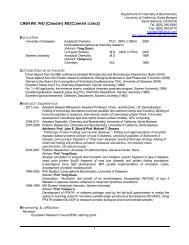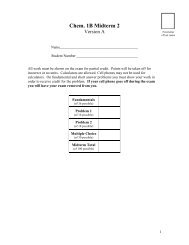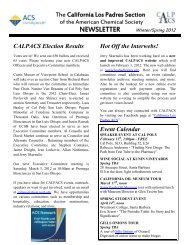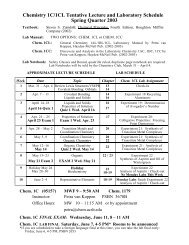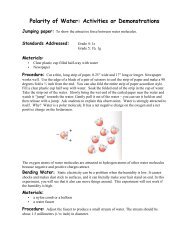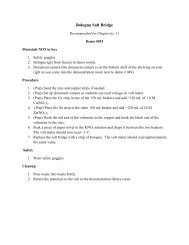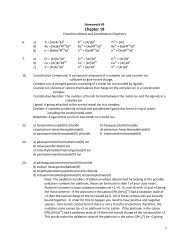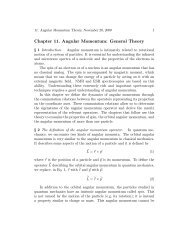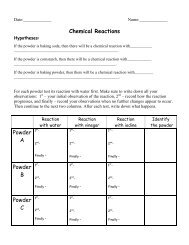Chem 124/224 – exam 2 1
Chem 124/224 – exam 2 1
Chem 124/224 – exam 2 1
You also want an ePaper? Increase the reach of your titles
YUMPU automatically turns print PDFs into web optimized ePapers that Google loves.
<strong>Chem</strong> <strong>124</strong>/<strong>224</strong> <strong>–</strong> <strong>exam</strong> 21. [a] Indicate the approximate chemical shift for each of the H’s in the proton NMR spectrum of isopropyl butyrate.[b] Assuming first order rules apply, specify the multiplicity and relative intensity of the peaks for each of the resonances.OO[c] Do the same as you’ve done for parts ‘a’ and ‘b’, this time for 4,4-dimethylcyclopent-2-en-1-one.OH AH B[d] Specify whether the pair, H A and H B , are homotopic, enantiotopic, or diastereotopic. Do the same for the gem methylunit.2. [a] Account (please be clear and concise) for the fact that the methyl group resonance(s) in the structure shown belowappear at <strong>–</strong>4.2 ppm (that’s minus 4.2).[b] Determine the number of signals that would appear in the fully decoupled 13-C NMR spectrum (i.e., the H’s are fullydecoupled from the C’s).[c] Are the methyl groups chemical shift equivalent? Why or why not?3. Draw resonance forms for each of the following structures, and use them to predict whether the vinyl H will appear upfieldor downfield of the standard position. Clearly and concisely describe your reasoning.HHNMe 2NO 24. Classify the spin systems to which the protons of the following molecules belong (e.g. A 2 X 2 , AA'XX' etc.). Assume thatany chemically non-equivalent protons are well separated in chemical shift.ClClClClSBrClBr5. Describe the appearance of the methine H of i-PrOH under the conditions of fast and slow exchange of the OH.6. Specify the approximate energy associated with each of the following forms of spectroscopy:[a] NMR[b] mass spectrometry (EI)[c] IR[d] UV7. The proton NMR spectrum of vinyl acetate is appended. Account for the splitting patterns for H(a), H(b), and H(c).[b] Specify, using a splitting tree, the spacings that correspond to each of the coupling constants, and identify which iswhich (e.g. cis coupling, etc).1
<strong>Chem</strong> <strong>124</strong>/<strong>224</strong> <strong>–</strong> <strong>exam</strong> 2[c] Which coupling is largest? Smallest?8. Account for the observation that in the region of the molecular ion, the mass spectrum of 2-bromobutane shows two peaksof equal abundance, and separated by two mass units.9. The mass spectrum of a methyltetrahydrofuran (MW 86) has a base peak at m/z 58. Which of the following structures ismost consistent with this information? Formulate a mechanism that accounts for the formation of the base peak.OOCH 3CH 310. The mass spectrum of an ester contains an intense ion at m/z 74 (70%). Which of the two structures given below is mostconsistent with this observation? Formulate a mechanism to account for its formation.OOOCH 3OCH 311. Account, mechanistically, for the formation of an intense ion of m/z 71 (C 4 H 7 O) in the mass spectrum of thesesquiterpene alcohol, linalool.OHlinalool12. Spectral data for the monoterpene, xylomollin, is tabulated below.H ppm multiplicity J (Hz)1 5.88 d 32 5.48 d 83 2.59 dd 10, 84 3.00 dddd 12, 10, 10, 55a 2.49 dd 17, 55b 2.54 dd 17, 126 4.52 dq 10, 77 1.75 ddd 10, 10, 3CO 2 CH 3O 4 OCH5 32O 6 1 O7xylomollinCH 3 OH[a] What is the value of the geminal coupling constant?[b] What can one conclude regarding stereochemistry from the magnitude of the coupling constants between H4 and the twoH’s at C5? What is the basis for your statement?[c] What can one conclude regarding stereochemistry from the magnitude of the coupling constant between H3 and H4?What is the basis for your statement?[d] What can one conclude regarding stereochemistry from the value of J 4,7 ? What is the basis for your statement?[e] Is the hydroxyl group positioned in an axial or an equatorial orientation? How do you know?[f] Repeat part ‘e’, this time for the OMe unit.[g] Do the same for the methyl group at C6.[h] Use the information you’ve uncovered to draw a conformationally meaningful representation of xylomollin.2





